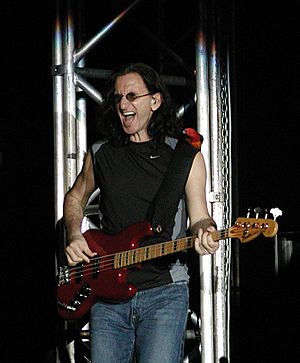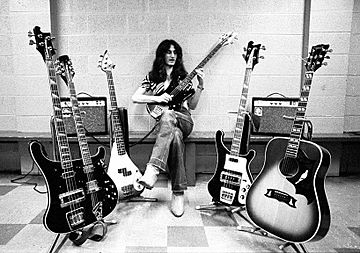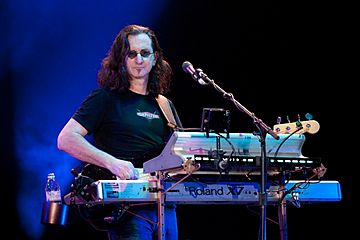Geddy Lee facts for kids
Quick facts for kids
Geddy Lee
|
|
|---|---|
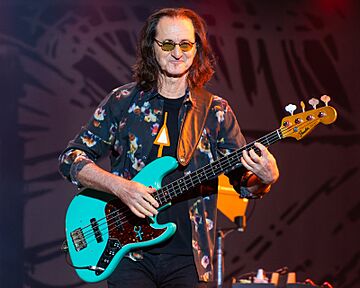
Lee performing at Wembley Stadium in 2022
|
|
| Background information | |
| Birth name | Gary Lee Weinrib |
| Born | July 29, 1953 North York, Ontario, Canada |
| Genres | |
| Occupation(s) |
|
| Instruments |
|
| Years active | 1968–present |
| Labels | |
| Signature | |
 |
|
Geddy Lee Weinrib (born Gary Lee Weinrib, July 29, 1953) is a Canadian musician. He is best known as the lead singer, bassist, and keyboard player for the rock band Rush. Geddy joined Rush in September 1968. His friend Alex Lifeson asked him to join. He took the place of the band's first bassist and singer, Jeff Jones. Geddy Lee also released a solo album called My Favourite Headache in 2000.
Geddy Lee's unique bass playing style has inspired many rock musicians. These include Cliff Burton from Metallica and Steve Harris from Iron Maiden. In 1996, Geddy Lee and his Rush bandmates, guitarist Alex Lifeson and drummer Neil Peart, were made Officers of the Order of Canada. This is a very high honor in Canada. They were the first rock band to receive it. In 2013, Rush was added to the Rock and Roll Hall of Fame. In 2006, Hit Parader magazine ranked Lee as the 13th greatest heavy metal singer of all time.
Contents
Early Life and Family History
Geddy Lee was born Gary Lee Weinrib on July 29, 1953, in Willowdale, Toronto, Canada. His parents, Morris and Mary, were from Poland. They were Jewish people who survived the the Holocaust during World War II. They met in a difficult camp and later survived other camps. After the war, they married and moved to Canada.
When Geddy started school, his name was written down wrong. For a while, he thought his middle name was "Lorne." Later, as a teenager, he saw his birth certificate and learned his middle name was actually "Lee."
Geddy's father passed away when Geddy was young. This meant his mother had to work hard to support their three children. She ran a store that his father had owned. Geddy believes his father's death might have led him to become a musician. He felt he needed to make his life count. This feeling inspired him to get the most out of his life and music.
Geddy turned his basement into a practice space for a band he started with high school friends. When the band started earning money from small shows, he decided to leave high school. He wanted to play rock and roll full-time. His mother was very upset at first. He wanted to show her he was serious and would work hard.
The name "Geddy" came from his mother's Polish way of saying his first name, "Gary." His friends at school picked up on it, and he started using it as his stage name. Later, he even made it his legal first name.
After Rush became famous, Geddy told the band's drummer and lyricist, Neil Peart, about his mother's experiences. Peart then wrote the lyrics for the song "Red Sector A." This song was inspired by her story. Geddy wrote the music for the song, which appeared on Rush's 1984 album, Grace Under Pressure. The song talks about hope and fear during difficult times.
Music Career Beginnings
Geddy Lee started playing music in school when he was about 10 or 11 years old. He got his first acoustic guitar at age 14. In school, he tried drums, trumpet, and clarinet. But he found learning instruments in school boring. He took basic piano lessons on his own. His interest grew a lot after he heard popular rock bands of the time. He was influenced by musicians like Jack Bruce of Cream and John Entwistle of The Who. He said he learned to play bass by trying to play like Jack Bruce.
In 1969, Rush started playing professionally in coffeehouses and at high school dances. By 1971, they were playing their own songs in small clubs. Geddy described these early years as being "weekend warriors." They worked regular jobs during the week and played music on weekends. He said music was a way for them to express themselves and escape their boring suburban lives. At first, they were just a "straightforward rock band."
To earn more money, they started opening concerts for other bands. By 1972, Rush was performing full concerts, mostly with their own songs, in cities like Toronto and Detroit. As they became more known, they opened for groups like Aerosmith and Kiss.
Geddy Lee's Unique Style
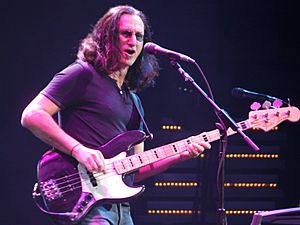
Rush was a "power trio," meaning they had only three members. Geddy Lee played bass and sang. His singing voice was very unique, often reaching high notes. He had a wide vocal range, but it changed as he got older. Geddy's bass playing style is known for its bright, high sound and for playing the strings very hard. He often used the bass as a lead instrument, playing melodies that went along with Alex Lifeson's guitar.
In the 1970s and early 1980s, Geddy mostly used a Rickenbacker 4001 bass. This bass gave him a gritty sound. In the mid-1980s, when the band used more synthesizers, he used Steinberger and later Wal basses. These had a more "jazzy" sound. From 1993 onwards, Geddy mostly used the Fender Jazz Bass. This brought back his signature high-treble sound. He had first used the Jazz Bass to record songs like "Tom Sawyer" on the Moving Pictures album.
Rising Popularity of Rush
After releasing several early albums and gaining fans, Rush's popularity grew quickly. Over five years, they toured worldwide and released successful albums. These included 2112 (1976), A Farewell to Kings (1977), and Moving Pictures (1981).
Geddy Lee started adding synthesizers to Rush's music in 1977. This expanded the band's sound and allowed them to create more complex progressive rock music. It also let Geddy play bass at the same time, as he could control the synthesizer with foot pedals. In 1981, Keyboard magazine named him "Best New Talent." By 1984, Geddy was surrounded by many keyboards on stage.
By the 1980s, Rush became one of the biggest rock bands in the world. They sold out large arenas when they toured. Geddy Lee was known for his energetic stage moves. Music critics noted his amazing ability to play multiple keyboards, use bass pedal controllers, and control other equipment, all while singing lead vocals. Few musicians could do so many things at once. Geddy's playing was the "pulse" of the group. It created a "one-man rhythm section" that worked perfectly with Alex Lifeson's guitar and Neil Peart's drums.
Many bass players have said Geddy Lee influenced them. These include Cliff Burton of Metallica, Steve Harris of Iron Maiden, and Les Claypool of Primus.
My Favourite Headache Solo Album
My Favourite Headache, Geddy Lee's solo album, was released on November 14, 2000. This happened while Rush was taking a break after some sad events in Neil Peart's life. Musicians who worked on the album included his friend and Rush collaborator Ben Mink and drummer Matt Cameron from Soundgarden and Pearl Jam.
Other Music Projects
Most of Geddy Lee's music work has been with Rush. However, he has also worked on other projects. He has appeared as a guest musician and produced albums for other artists.
In 1981, Geddy was a guest on the hit song "Take Off" with the comedy characters Bob and Doug McKenzie. This song was the highest-charting single of Geddy Lee's career on the Billboard charts.
Geddy Lee sang "O Canada", the Canadian national anthem, at a baseball game in Baltimore in 1993. Another rock version of "O Canada" was recorded by Geddy and Alex Lifeson for the 1999 film soundtrack South Park: Bigger, Longer, and Uncut.
In 2006, Geddy joined Alex Lifeson's supergroup, the Big Dirty Band. They provided songs for Trailer Park Boys: The Movie. In 2017, Geddy performed with the band Yes at their Rock and Roll Hall of Fame induction. He played bass for their song "Roundabout."
In 2020, Geddy provided guest vocals for an all-star Canadian version of the song "Lean on Me." This was for a TV special to help Food Banks Canada during the COVID-19 pandemic. In 2020, Rolling Stone magazine ranked him as the 24th greatest bassist of all time.
In 2022, he appeared as a guest star on the Canadian TV show Murdoch Mysteries. In November 2023, Geddy Lee published his autobiography called My Effin' Life. He promoted the book with a tour in the UK and North America. In December 2023, Paramount+ released a video series called "Geddy Lee Asks: Are Bass Players Human Too?" In this series, Geddy visits and talks with other famous bass players.
Collections and Hobbies
Geddy Lee is a collector. He collects baseball items, old bass guitars, and wines. He has a collection of 5,000 wine bottles. As a child, he collected stamps and vinyl records. He also collects first edition books and watches.
Baseball Fan
Geddy Lee is a big baseball fan. His favorite team growing up was the Detroit Tigers. Later, he became a fan of the Toronto Blue Jays when they started. He collects baseball memorabilia and has donated some of his collection to the Negro Leagues Baseball Museum. He threw the ceremonial first pitch for the 2013 Toronto Blue Jays season. Geddy is often seen in his seat behind home plate at the Toronto Blue Jays stadium, Rogers Centre, keeping score.
Guitars and Basses
Geddy Lee also collects guitars and basses. He has a collection of over 250 vintage basses. He owns a 1961 Fender Precision Bass that used to belong to John Entwistle of The Who. He also has two 1964 Fender Jazz Basses in a rare Dakota Red color.
In 2019, Geddy sent some of his guitars to an auction. These included a 1959 Les Paul Standard and a 1967 Gibson Flying V.
Equipment Used
Basses
In the early days of Rush, Geddy used a Fender Precision Bass. Later, he got a black Rickenbacker 4001 bass, which was his main instrument until the early 1980s.
In 1998, Fender released the Geddy Lee Jazz Bass. This special model is a copy of Geddy's favorite bass, a 1972 Fender Jazz that he bought in 1978. In 2015, Fender released an updated version of his signature bass.
Geddy Lee has always used RotoSound strings. He uses Swing Bass RS66LD strings on most of his basses.
Bass Amplification
For Rush's 2010 tour, Geddy used two Orange AD200 bass heads and two OBC410 4x10 bass cabinets.
Keyboards and Synthesizers
Over the years, Geddy Lee has used many different synthesizers. These include models from Oberheim, PPG, Roland, Moog, and Yamaha.
Live Performances: Special Equipment
Recreating Sounds
New technology in synthesizers and samplers allows Geddy to store sounds from his old synthesizers. He can also create new sounds. For live shows, Geddy and his keyboard technician use special equipment to create almost all of Rush's keyboard sounds. They can also make complex sound parts that used to need many machines.
To play these sounds during a show, Geddy uses MIDI controllers. These are placed near his microphone stands on stage. He uses keyboard-like controllers and large foot-pedal keyboards. This lets him use his hands and feet to play sounds from electronic equipment that is off-stage. This technology helps Rush play their songs live with all the complex sounds their fans expect. They don't need to use pre-recorded tracks or have extra band members.
Unique Stage Equipment

In 1996, Geddy Lee stopped using traditional bass amplifiers on stage. Instead, he sent his bass guitar sound directly to the sound board. This gave him better control and sound quality.
Since he no longer had large amplifier cabinets on stage, Geddy decided to decorate his side of the stage with unusual items. For the Snakes & Arrows Tour, he had three rotisserie chicken ovens on stage! There was even a person dressed as a chef to "tend" the chickens during the shows.
Awards and Recognition
- 1990: The Royal Astronomical Society of Canada named Asteroid (12272) Geddylee after him.
- 1994: With Rush, he was inducted into the Juno Hall of Fame.
- 1996: He was made an Officer of the Order of Canada, along with his bandmates Alex Lifeson and Neil Peart.
- 2007: Won "Best Album for Bass" (Snakes & Arrows) from Bass Player magazine.
- 2010: With Rush, received a Star on the Hollywood Walk of Fame.
- 2012: Received the Queen Elizabeth II Diamond Jubilee Medal.
- 2013: With Rush, inducted into the Rock and Roll Hall of Fame.
- 2021: Received a Lifetime Achievement Award for his charity work at the Artists for Peace and Justice (APJ) annual gala.
Personal Life
Geddy Lee married Nancy Young in 1976. They have a son and a daughter. He enjoys taking trips to France every year, where he likes to try different cheeses and wines. In 2011, a charity he supports, Grapes for Humanity, created the Geddy Lee Scholarship for students studying winemaking. Geddy Lee has described himself as a Jewish atheist. He explained that he considers himself Jewish by heritage, but not by religion.
Books
- Geddy Lee's Big Beautiful Book of Bass (2018)
- My Effin' Life (2023)
See also
 In Spanish: Geddy Lee para niños
In Spanish: Geddy Lee para niños


